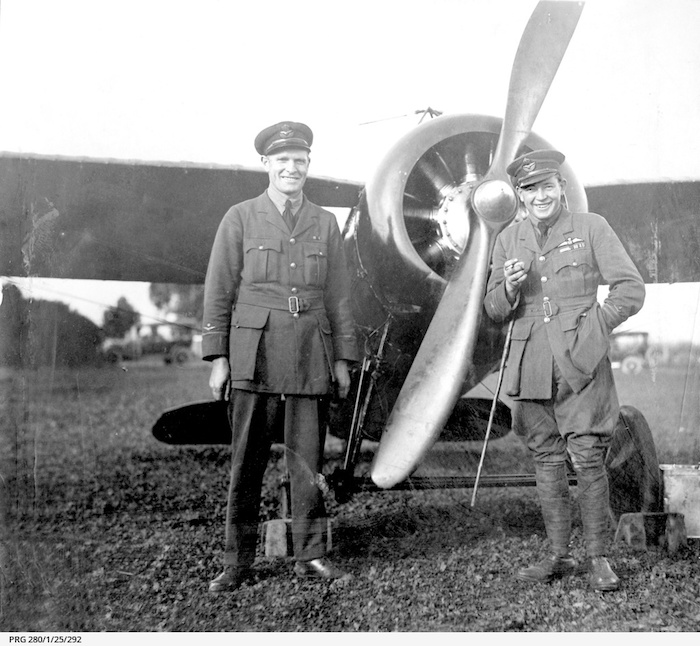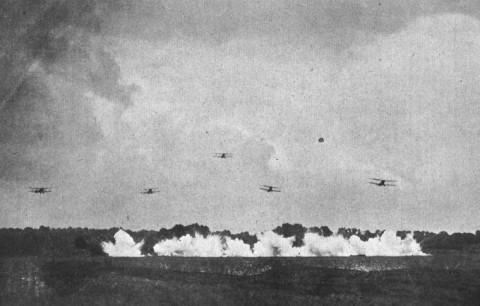
I recently learned that Adelaide has a suburb called Hendon. Naturally, I wondered if there was a connection to the Hendon, the most important site for aerial theatre in Britain both before and after the First World War. And the answer is: yes!
In 1919, two Australian RAF veterans, Harry Butler (above, right) and Harry Kauper (above, left), returned home and began a joint flying venture, the Harry J. Butler & Kauper Aviation Co., ‘[Manufacturers] and Importers of Aircraft, Motor Cars and Merchandise, with subsidiary interests as Motor and General Engineers and in Aerial and Passenger Carrying and Advertising Services’.1 From the company’s name, we may guess that Butler was the more prominent of the two: after a wartime career spent mainly as a flight instructor in Britain with occasional detours over France, he gained fame in South Australia in 1919 for his aerobatics and a cross-water airmail flight in a Bristol M.1 monoplane named ‘Red Devil’ (above, rear; still on display at Minlaton, Butler’s hometown). But Kauper, who was an engineer rather than a pilot, had the more interesting aviation career. He had gone to Britain in 1911 along with his friend, Harry Hawker — as in Hawker Aircraft (though he died in a crash before any of its aircraft flew). They both went to work for Tom Sopwith even before he founded his eponymous company, helping to develop the Tabloid. After Hawker and Kauper’s abortive (but lucrative) attempt at the Circuit of Britain race in 1913, they both continued to work at Sopwith during the war, Hawker as a designer and test pilot, Kauper as works manager — he came up with Sopwith’s version of the synchronisation gear. In 1919, their paths diverged: Hawker stayed in Britain to work with Sopwith and Kauper came back to Australia to form a new partnership with Butler.
Butler and Kauper initially set up operations at Northfield, which then would have been on the northern edge of Adelaide. But their aerodrome there lacked good transport connections for public access, so in October 1920 they relocated about 8 miles east to Albert Park, where Butler promised ‘flying every day (Sundays excepted)’.2 This was also then a largely rural area, but it was ‘five minutes’ walk from the Albert Park railway-station on the Henley Beach line, and seven minutes’ from the stopping place of the Port Adelaide electric tram’.3 Albert Park was later purchased by the Commonwealth and became Adelaide’s official aerodrome — everyone from Alan Cobham to Charles Kingsford-Smith passed through.
What does all this have to do with Hendon? In December 1920, the estate agents Wilkinson, Sando and Wyles announced the sale of ’44 BUILDING SITES in the immediate vicinity of the Butler-Kauper Aviation Company’s New Aerodrome’, which they described as being located at ‘”Hendon”‘, quotation marks included.4 A short article in the Register explained that Hendon was to be a new residential subdivision, ‘appropriately styled Hendon, after the famous English flying centre’.5
So that’s where the name Hendon came from: a land developer’s attempt to capitalise on the flying craze by emphasising the proximity of aeroplanes taking off and landing and hinting that a free air display could be seen every day (weather permitting). This apparently insane scheme seems to have worked, because by March 1921 all the lots had been sold, and Butler subdivided some of his own land for sale.6 Ironically, the excellent transport links brought more and more people to live in Hendon, which became more and more built-up, leading to the Albert Park aerodrome — oddly, it never seems to have been called Hendon aerodrome — was abandoned in 1927 in favour of a new site at Parafield. By that time, the Harry J. Butler & Kauper Aviation Co. had folded; Butler was dead and Kauper had switched to a career in another new industry, radio. But Hendon is still here, without the aeroplanes.
Image source: State Library of South Australia.
![]() This work is licensed under a Creative Commons Attribution-NonCommercial-NoDerivatives 4.0 International License.
Permissions beyond the scope of this license may be available at http://airminded.org/copyright/.
This work is licensed under a Creative Commons Attribution-NonCommercial-NoDerivatives 4.0 International License.
Permissions beyond the scope of this license may be available at http://airminded.org/copyright/.





